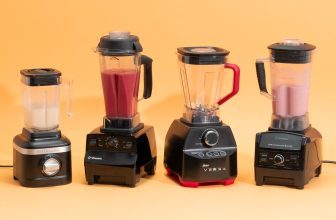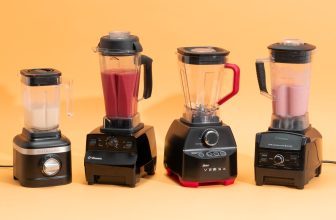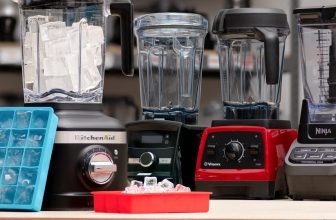As an Amazon Associate I earn from qualifying purchases.
Should I Get A Blender Or Food Processor?
Should I Get A Blender Or Food Processor? What if I told you that the right kitchen appliance could cut your meal prep time in half? Many home cooks find themselves at a crossroads when deciding between a blender and a food processor. Each gadget, though similar in some ways, brings unique advantages to your culinary toolbox.
Blenders, originating in the early 20th century, excel at liquefying ingredients, ideal for smoothies and soups. Food processors, however, made their mark in the 1960s and shine in tasks like chopping, slicing, and kneading dough. According to a survey, 64% of Americans own a blender, yet many wonder if they could benefit more from the versatility of a food processor.
:max_bytes(150000):strip_icc()/Cuisinart-Vs-Vitamix-7fe65962cd9e475f960402240a580a0a.png)
Understanding Blender and Food Processor Functions
Blenders are primarily used for mixing and puréeing ingredients. They are perfect for making smoothies, soups, and sauces. Blenders have powerful motors that can crush ice, making them ideal for frozen drinks. Besides blending, they can also emulsify liquids for salad dressings. However, they aren’t great for chopping or slicing solid foods.
On the other hand, food processors are designed for various food prep tasks. They come with multiple blades and disks, allowing you to chop, slice, shred, and knead dough. Unlike blenders, food processors handle solid and semi-solid ingredients with ease. They are handy for making pie dough, slicing vegetables, and grating cheese. Food processors come in various sizes, suitable for different tasks.
Here’s a quick look at their core functions:
- Blender: Smoothies, soups, emulsifying liquids
- Food Processor: Chopping, slicing, shredding, kneading dough
When deciding which appliance to use, consider your cooking needs. If you frequently make soups and smoothies, a blender is the way to go. For more versatile tasks like chopping veggies and making dough, a food processor may be better. Sometimes, having both appliances can be the optimal solution for a complete kitchen. Either way, knowing their functions helps make an informed choice.
The Role of a Blender in the Kitchen
Blenders have become indispensable in modern kitchens due to their versatility. They excel at making smoothies, allowing you to blend fruits, veggies, and liquids into a smooth drink. The ability to crush ice also makes them perfect for refreshing frozen drinks. In addition to drinks, blenders can purée soups to a creamy consistency. This functionality is especially useful for making baby food or creamy sauces.
Another important role of blenders is emulsification. This process mixes two liquids that usually do not combine well, like oil and vinegar. It’s perfect for creating smooth salad dressings and homemade mayonnaise. The high-speed blades ensure a fine and consistent mixture. This can greatly elevate your homemade dishes.
Blenders also help in making batters and dough. For instance, pancake or waffle batter can be mixed quickly and smoothly. Some blenders even have preset options for different tasks. This adds to their convenience and ease of use. Below is an overview of popular blender uses:
- Smoothies
- Sauces
- Batters
- Dressings
Many blenders now come with additional features that expand their usability. Some high-end models include heating options, allowing you to blend soups and cook them right in the jar. This makes the cooking process more efficient. With a variety of models on the market, you can find one that meets your specific needs. Investing in a quality blender can significantly improve your kitchen experience.
The Functionality of a Food Processor
A food processor is a versatile tool in any kitchen, designed to handle a variety of tasks. It can chop, slice, and dice vegetables in seconds. This is especially useful when preparing large meals or batch cooking. The appliance typically comes with interchangeable blades and disks. Each attachment serves a unique purpose, from slicing potatoes to grating cheese.
Food processors also excel at making dough. Whether you’re preparing pizza dough or pie crust, the machine saves time and effort. The powerful motor ensures consistent mixing. Many food processors have a pulse function to control the texture of your mixture. This feature is particularly useful when making chunky salsas or finely chopped nuts.
Here’s a list of key functions:
- Chopping vegetables
- Slicing and shredding
- Mixing dough
- Pulsing for texture control
Another unique aspect is its ability to blend thick mixtures, such as hummus or nut butter. Unlike blenders, food processors can handle less liquid and more solid ingredients. This broad functionality makes it indispensable for anyone who enjoys cooking. Investing in a reliable food processor can drastically cut down preparation time. This frees up more time for cooking and enjoying meals.
Key Factors to Consider Before Purchase
When deciding between a blender and a food processor, the first factor to consider is your cooking needs. Do you frequently make smoothies, soups, or sauces? If so, a blender may be the better choice. On the other hand, if you do a lot of chopping, slicing, and dough making, a food processor could be more beneficial. Analyzing your cooking habits is crucial in making the right decision.
Another important aspect is the available space in your kitchen. Blenders are generally more compact and can easily fit on most countertops. Food processors, especially those with multiple attachments, may take up more space. Consider where you will store the appliance when not in use. If counter space is limited, a blender might be the better option.
Ease of cleaning is also a significant factor. Blenders typically have fewer parts, making them easier to clean. Most blender jars and lids are dishwasher safe. Food processors, with their various blades and disks, can be more cumbersome to wash. Think about how much time you are willing to spend on cleanup.
Budget is another key element to think about. High-end blenders and food processors can be expensive, but there are affordable options available. Blenders generally have a broader price range, from basic models to high-powered ones. Food processors also vary in price based on features and capacity. Define your budget to narrow down your options.
Here’s a quick comparison to help:
| Factor | Blender | Food Processor |
|---|---|---|
| Primary Use | Smoothies, soups, sauces | Chopping, slicing, dough |
| Space | Compact | Requires more space |
| Cleaning | Easy | Complex |
| Budget | Varies widely | Varies by feature |
Finally, think about the versatility of each appliance. Some blenders come with features that overlap with food processors, like chopping and grinding. Similarly, food processors may offer blending functions. Evaluating these capabilities can help you decide if one appliance can meet all your needs, saving you both money and space.
Comparing Advantages and Disadvantages of Blenders and Food Processors
Blenders offer several advantages that make them stand out. One of the main benefits is their ability to liquefy ingredients quickly, making them ideal for smoothies and soups. They also excel at crushing ice for frozen drinks. However, blenders can struggle with tasks involving solid or dense ingredients. Their design is more suited for liquid-based recipes.
On the downside, blenders often have limited versatility compared to food processors. They generally can’t chop vegetables or knead dough efficiently. Another limitation is their capacity; most blenders have smaller jars. This can be a drawback when making large batches of food. Additionally, high-quality blenders can be pricey.
Food processors boast a broad range of functionalities. They can chop, slice, shred, and even knead dough, making them multi-purpose kitchen tools. The ability to handle both liquid and solid ingredients sets them apart. Food processors are excellent for preparing large meals or batch cooking. They also come in various sizes to suit different needs.
However, food processors also have their drawbacks. These appliances tend to take up more counter space and come with multiple attachments, making storage a bit challenging. Cleaning can be cumbersome due to the numerous parts involved. Another disadvantage is the noise; food processors can be quite loud during operation. Lastly, while they are versatile, they may not blend liquids as smoothly as blenders.
Here’s a quick comparison to help:
| Feature | Blender | Food Processor |
|---|---|---|
| Key Function | Liquefying | Chopping, slicing |
| Versatility | Limited | High |
| Ease of Cleaning | Simple | Complex |
| Storage | Compact | Bulky |
| Noise Level | Moderate | Loud |
Weighing these advantages and disadvantages can help you determine which appliance better suits your cooking needs. Keep your kitchen tasks and available space in mind when making the decision. Both blenders and food processors offer unique benefits, so choose the one that aligns best with your culinary habits. A well-thought-out choice will make meal prep more enjoyable and efficient.
Ever-Merging Features of Blenders and Food Processors
In recent years, blenders and food processors have seen a blend of functionalities. Some high-end blenders now come with attachments that allow for basic chopping and slicing. This helps users perform tasks traditionally reserved for food processors. These additions make the appliance more versatile and useful. As a result, they are increasingly taking center stage in modern kitchens.
Similarly, food processors are evolving with advanced blending features. Some models now include additional containers designed for better liquid handling. They can purée soups and make smoothies almost as effectively as blenders. This significant overlap reduces the need for multiple appliances. Users enjoy the convenience of having one machine for various cooking tasks.
Manufacturers are keen on capitalizing on this trend, offering combo appliances. These often come with interchangeable jars and attachments, serving both blending and processing roles. They are marketed as all-in-one solutions, aiming to save space and money for consumers. Below is an overview of such features:
- Blending containers for food processors
- Chopping blades for blenders
- All-in-one combo appliances
Moreover, technological advancements have made these appliances more user-friendly. Features like pre-set programs, touch screens, and smart connections add to the ease of use. These modern touches make kitchen tasks quicker and reliable. With ongoing innovations, the lines between blenders and food processors will continue to blur, offering even more options for home cooks.
This merging of functionalities benefits consumers by minimizing kitchen clutter and maximizing utility. However, it also means that making a purchasing decision requires thorough research. It’s essential to look at the specific features and functions you need. Doing so ensures that you get the most value and convenience from your chosen appliance.
Making the Final Decision: Blender or Food Processor
Deciding whether to buy a blender or food processor depends on your specific cooking needs and lifestyle. If you love making smoothies, soups, and sauces, a blender might be more beneficial. Blenders are known for their ability to liquefy ingredients quickly. They are also easier to clean and generally take up less counter space. This makes them a great fit for smaller kitchens.
On the other hand, if your meals often involve chopping vegetables, slicing fruits, or kneading dough, a food processor is better suited for you. Food processors offer a wide range of functionalities with various blades and disks. They excel in tasks that require solid ingredient preparation. However, they tend to take up more space and can be more complex to clean.
If you’re still unsure, consider combo appliances that offer both blending and processing capabilities. These multi-functional machines come with interchangeable jars and attachments. They aim to provide the best of both worlds in one compact package. Combo units can save both money and storage space in your kitchen.
- Blender: Smoothies, soups
- Food Processor: Chopping, slicing
- Combo Appliance: Best of both worlds
Your budget will also play a significant role in this decision. Blenders generally have a wider price range from basic models to high-end options with advanced features. Food processors vary in price based on their capacity and additional attachments included. Ensure that whatever you choose fits within your financial plan while meeting your culinary needs.
Ultimately, think about how much time you’ll spend using each appliance versus cleaning it. You don’t want an appliance that ends up being too much work for everyday use. Evaluate all these factors carefully before making your final decision.. With thoughtful consideration, you’ll find the appliance that perfectly complements your cooking style.
Frequently Asked Questions
If you’re torn between choosing a blender and a food processor, you’re not alone. Here are some commonly asked questions to help you make an informed decision.
1. What are the primary uses for a blender?
A blender is most effective for making smoothies, shakes, and soups. It can blend liquids and soft foods to create a smooth consistency. Blenders are also great for emulsifying sauces and dressings, thanks to their high-speed blades. Some high-powered blenders can even crush ice for frozen drinks.
Additionally, blenders can be used for tasks such as puréeing baby food or preparing pancake batter. Their compact size makes them easy to store and clean. Preset programs have made the process more straightforward than ever before.
2. How does a food processor differ from a blender?
A food processor excels at handling solid and semi-solid ingredients. It’s ideal for chopping vegetables, slicing fruits, shredding cheese, and kneading dough. Unlike blenders, food processors come with various blades and discs tailored for specific tasks.
The motor in a food processor is typically stronger than that of a blender, designed to power through tougher tasks without overheating or stalling. This makes it perfect for preparing large meals or batch cooking efficiently.
3. Can I use a blender to chop vegetables?
While you technically can chop softer vegetables in a blender using the pulse function, it’s not ideal for precise cuts or harder vegetables like carrots or potatoes. The blades in blenders are not designed specifically for chopping and may result in uneven pieces.
If you frequently need chopped veggies with consistent texture and size, investing in a food processor will save time and give better results. Food processors have attachments specifically designed for chopping, ensuring uniformity.
4. Are there any appliances that combine both functions?
Yes, several combo appliances offer both blending and processing capabilities with interchangeable jars and attachments. These hybrid models aim to provide the best of both worlds while saving counter space.
While these combo units are convenient, they might fall short in mastering either task exceptionally well compared to dedicated single-purpose machines—so that’s something worth considering based on your cooking habits.</p
5. What factors should I consider when purchasing either appliance?
- Your primary cooking needs (smoothies vs chopping)
- Available kitchen space
- Ease of cleaning
- Your budget
- The versatility of the appliance</li
<
. Furthermore sufficiently examining brands.e models ensure greater satisfaction suitable functionality pertaining specific culinary requirements ,ljen though investing wisely assist effectively serving preferred dishes completions regularly!
Final Thoughts
Choosing between a blender and a food processor ultimately hinges on your specific culinary needs and kitchen space. Blenders are ideal for liquefying and blending tasks, making them perfect for smoothies and soups. In contrast, food processors excel in more diverse tasks like chopping and kneading dough, offering true versatility for recipe prep.
Investing in the right appliance can greatly enhance your cooking efficiency and satisfaction. Whether you opt for a blender, a food processor, or a combo model, aligning your choice with your culinary habits ensures you get maximum value. Remember, thoughtful consideration today leads to effortless meal preparation tomorrow.






